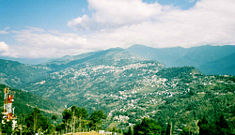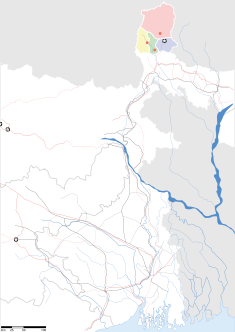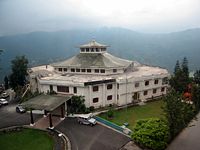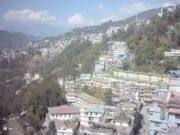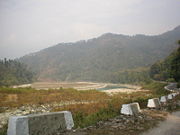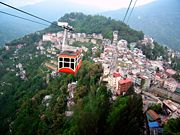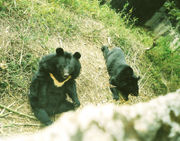Gangtok
2008/9 Schools Wikipedia Selection. Related subjects: Geography of Asia
| ?Gangtok Sikkim • India |
|
|
|
|
|
|
|
| Coordinates: | |
| Time zone | IST ( UTC+5:30) |
| Area • Elevation |
25 km² (10 sq mi) • 1,437 m (4,715 ft) |
| District(s) | East Sikkim |
| Population • Density |
29,162 (2001) • 2,000 /km² (5,180 /sq mi) |
| Mayor | – |
| Codes • Pincode • Telephone • Vehicle |
• 737101 • +03592 • SK-01, SK-02, SK-03, SK-04 |
Coordinates: Gangtok pronunciation ( Nepali and Hindi: गंगटोक) is the capital and largest town of the Indian state of Sikkim. Gangtok is located in the Sivalik Hills of the eastern Himalayan range, at an altitude of 1,437 metres (4,715 ft). The town, with a population of thirty thousand belonging to different ethnicities such as Nepalis, Lepchas and Bhutia, is administered by various departments of the Government of Sikkim. Nestled within higher peaks of the Himalaya and enjoying a year-round mild temperate climate, Gangtok is at the centre of Sikkim’s tourism industry.
Gangtok rose to prominence as a popular Buddhist pilgrimage site after the construction of the Enchey Monastery in 1840. In 1894, the ruling Sikkimese chogyal, Thutob Namgyal, transferred the capital to Gangtok. In the early 20th century, Gangtok became a major stopover on the trade route between Lhasa in Tibet and cities such as Kolkata (then Calcutta) in British India. After the British granted India its independence in 1947, Sikkim chose to remain an independent monarchy, with Gangtok as its capital. In 1975, after the integration with the union of India, Gangtok was made India's twenty-second state capital.
The precise meaning of the name Gangtok is unclear, though the most popular meaning is "hill top". Today, Gangtok is a centre of Tibetan Buddhist culture and learning, with the presence of several monasteries, religious educational institutions, and centres for Tibetology.
History
Like the rest of Sikkim, not much is known about the early history of Gangtok. The earliest records date from the construction of the hermitic Gangtok monastery in 1716. Gangtok remained a small hamlet until the construction of the Enchey Monastery in 1840 made it a pilgrimage centre. After the defeat of the Tibetans by the British, Gangtok became a major stopover in the trade between Tibet and British India at the end of the 19th century. Most of the roads and the telegraph in the area were built during this time.
In 1894, Thutob Namgyal, the Sikkimese monarch under British rule, shifted the capital from Tumlong to Gangtok, increasing its importance. A new grand palace along with other state buildings was built in the new capital. Following India's independence in 1947, Sikkim became a nation-state with Gangtok as its capital. Sikkim became a suzerain of India, with the condition that it would retain its independence, by the treaty signed between the Chogyal and the then Indian Prime Minister Jawaharlal Nehru. Trade between India and Tibet continued to flourish through the Nathula and Jelepla passes, offshoots of the ancient Silk Road near Gangtok. These border passes were sealed after the Sino-Indian War in 1962, which deprived Gangtok of its trading business. In 1975, the monarchy was abrogated and Sikkim became India's twenty-second state, with Gangtok as its capital. Gangtok has witnessed annual landslides, resulting in damage to life and properties. The largest disaster occurred in June 1997, when 38 were killed and hundreds of buildings were destroyed.
Geography
Gangtok is located at . It is situated in the lower Himalayas at an altitude of 5,500 ft (1,676 m). In addition to being the state capital, it is the headquarters of the East Sikkim district. The town lies on one side of a hill, with "The Ridge", a promenade housing the governor's residence at one end and the palace, situated at an altitude of about 6,000 ft (1,829 m), at the other. The city is flanked on east and west by two streams, namely Roro Chu and Ranikhola, respectively. These two rivers divide the natural drainage into two parts, the eastern and western parts. Both the streams meet the Ranipul and flow south as the main Ranikhola before it joins the Teesta at Singtam. Most of the roads are steep, with the buildings built on compacted ground alongside them.
Most of Sikkim including Gangtok is covered by the Precambrian rock and is much younger in age. These rock contain phyllites and schists and therefore the slopes are prone to frequent landslides. Surface runoff of water by natural streams (jhora) and man-made drains has contributed to the risk of landslides. According to the Bureau of Indian Standards, the town falls under seismic zone-IV, (on a scale of I to V, in order of increasing proneness to earthquakes) near the convergent boundary of the Indian and the Eurasian tectonic plates and is subject to frequent quakes. The hills are nestled within higher peaks and the snow-clad Himalayan ranges tower over the town in the distance. Mount Kanchenjunga (8,598 m or 28,208 ft)—the world's third-highest peak—is visible to the east of the city. The existence of steep slopes, vulnerability to landslides, large forest cover and inadequate access to most areas has been a major impediment to the natural and balanced growth of the city.
There are densely forested regions around Gangtok, consisting of temperate, deciduous forests of poplar, birch, oak, and elm, as well as evergreen, coniferous trees of the wet alpine. Orchids are common, and rare varieties of orchids are featured in flower shows in the city. Bamboos are also abundant. In the lower reaches of the town, the vegetation gradually changes from alpine to subtropical and temperate deciduous. Flowers such as sunflower, marigold, poinsettia, and others bloom especially in November and December.
Climate
| Climate chart for Gangtok | |||||||||||
|---|---|---|---|---|---|---|---|---|---|---|---|
| J | F | M | A | M | J | J | A | S | O | N | D |
|
30.9
12
4
|
79.1
14
5
|
116
18
9
|
289.2
21
11
|
552.6
22
13
|
603.1
22
16
|
649.6
22
17
|
574
22
16
|
487.7
22
15
|
181.1
21
12
|
40
18
9
|
22.7
14
5
|
| temperatures in °C precipitation totals in mm source: Meteorological Centre, Gangtok |
|||||||||||
|
Imperial conversion
|
|||||||||||
Because of its elevation and sheltered environment, Gangtok enjoys a mild, temperate climate all year round. Like most Himalayan towns, Gangtok has five seasons: summer, monsoons, autumn, winter and spring. Temperatures range from an average maximum of 22 °C (72 °F) in summer to an average minimum of 4 °C (39 °F) in winter. Summers (lasting from late April to June) are mild, with maximum temperatures rarely crossing 25 °C (77 °F). The monsoon season from June to September is characterised by intense torrential rains often causing landslides that block Gangtok's land access to the rest of the country. Rainfall starts to rise from pre- monsoon in May, and peaks during the monsoon, with July recording the highest monthly average of 649.6 mm (25.6 in). In winter temperature averages between 4 °C (39 °F) and 7 °C (45 °F). Snowfall is rare, and in recent times Gangtok has received snow only in 1990, 2004 and 2005. Temperatures below freezing are also rare. During this season the weather can be sporadic, and change abruptly from bright sunshine and clear skies to heavy rain within a couple of hours. During spring and autumn the weather is generally sunny and mild. Owing to its elevation, Gangtok is often enveloped in fog during the monsoon and winter months.
Economy
The hospitality industry is the largest industry in Gangtok as the city is the main base for Sikkim tourism. Summer and spring seasons are the most popular tourist seasons. Many of Gangtok's residents employed directly and indirectly in the tourism industry, with many residents owning and working in hotels and restaurants. Ecotourism has emerged as an important economic activity in the region which includes trekking, mountaineering, river rafting and other nature oriented activities. An estimated 3,51,000 tourists visited Sikkim in 2007, generating revenue of about Rs 50 crores (Rs 500 millions).
The Nathula Pass, located about 50 km (31 mi) from Gangtok, used to be the primary route of the wool, fur and spice trade with Tibet and spurred economic growth for Gangtok till the mid-20th century. In 1962, after the border was closed during the Sino-Indian War, Gangtok fell into recession. The pass was reopened in 2006 and trade through the pass is expected to boost the economy of Gangtok. The Sikkim government is keen to open a Lhasa-Gangtok bus service via Nathula pass. Sikkim's mountainous terrain results in the lack of train or air links, limiting the area's potential for rapid industrial development. The government is the largest employer in the city, both directly and as contractors.
Gangtok's economy does not have a large manufacturing base, but has a thriving Cottage industry in watch-making, country-made alcohol and handicrafts. Among the handicrafts are the handmade paper industry made from various vegetable fibres or cotton rags. The main market in Gangtok provides many of the state's rural residents a place to offer their produce during the harvest seasons. The majority of the private business community is made up of Marwaris and Biharis. As part Sikkim, Gangtok enjoys the status of being income-tax free region as per state's 1948 Income tax law. As Sikkim is a frontier state, the Indian army maintains a large presence in the vicinity of Gangtok. This leads to a population of semi-permanent residents who bring money into the local economy. The Sikkim government started India's first online lottery Playwin to boost government income but was later closed by a ruling from Sikkim High Court.
Civic administration
Gangtok is not administered by a municipality but directly by the various departments of Government of Sikkim, particularly the Urban Development and Housing Department (UDHD) and Public Health Engineering Department (PHED). These departments look after the civic functions such as garbage disposal, water supply, tax collection, license allotments, and civic infrastructure. An administrator appointed by the state government heads the UDHD. The Sikkim Municipal Act, 2007 has approved the formation of Gangtok Municipal Corporation to be made up of 12 wards and which shall take over the administration from the UDHD. Elections to the wards of the first municipal corporation are to be held on June 11, 2008.
As the headquarters of East Sikkim district, Gangtok houses the offices of the district collector, an administrator appointed by the Union Government of India. Gangtok is also the seat of the Sikkim High Court, which is India's smallest High Court in terms of area and population of jurisdiction. Gangtok does not have its own police commissionerate like other major cities in India. Instead, it comes under the jurisdiction of the state police, which is headed by a Director General of Police, although an Inspector General of Police oversees the town. Sikkim is known for its very low crime rate. Rongyek jail in Gangtok is Sikkim's only central jail.
Gangtok is within the Sikkim Lok Sabha constituency that elects a member to the Lok Sabha ( Lower House) of the Indian Parliament. The city elects one member in the Sikkim state legislative assembly, the Vidhan Sabha. The Sikkim Democratic Front (SDF) won both the parliamentary election in 2004 and the state assembly seat in the 2004 state assembly polls.
Utility services
Electricity is supplied by the power department of the Government of Sikkim. Gangtok has a nearly uninterrupted electricity supply due to Sikkim's numerous hydroelectric power stations. The rural roads around Gangtok are maintained by the Border Roads Organisation, a division of the Indian army. Several roads in Gangtok are reported to be in a poor condition, whereas building construction activities continue almost unrestrained in this city lacking proper land infrastructure. Most households are supplied by the central water system maintained and operated by the PHED. The main source of PHED water supply is the Rateychu River, located about 16 km (9.9 mi) from the city, at an altitude of 2,621 m (8,600 ft). Its water treatment plant is located at Selep. The river Rateychu is snow-fed and has perennial streams. Since there is no habitation in the catchment area except for a small army settlement, there is little environmental degradation and the water is of very good quality. 40 seasonal local springs are used by the Rural Management and Development Department of Sikkim Government to supply water to outlying rural areas.
Around 40% of the population has access to sewers. However, only the toilet waste is connected to the sewer while sullage is discharged into the drains. Without a proper sanitation system, the practice of disposing sewage through septic tanks and directly discharging into Jhoras and open drains is prevalent. The entire city drains into the two rivers, Ranikhola and Roro Chu, through numerous small streams and Jhoras. Ranikhola and Roro Chu rivers confluence with River Teesta, the major source of drinking water to the population downstream. The densely populated urban area of Gangtok does not have a combined drainage system to drain out the storm water and waste water from the buildings. The estimated solid waste generated in Gangtok city is approximately 45 Tonne. Only around 40% of this is collected by UDHD, while the remainder is indiscriminately thrown into Jhora, streets and valleys. The collected waste is disposed in a dump located about 20 km (12 mi) from the city. There is no waste collection from inaccessible areas where vehicles cannot reach, nor does any system of collection of waste exist in the adjoining rural areas. The city is under a statewide ban on the use of polythene bags.
Transport
Taxis are the most widely available public transport within Gangtok. Most of the residents stay within a few kilometres of the town centre and many have their own vehicles such as two-wheelers and cars. The share of personal vehicles and taxis combined is 98% of Gangtok's total vehicles, a high percentage when compared to other Indian cities. City buses comprise less than one percent of vehicles. Those travelling longer distances generally make use of share-jeeps, a kind of public taxis. Four wheel drives are used to easily navigate the steep slopes of the roads. The 1 km (0.6 mi) long cable car with three stops connects lower Gangtok suburbs with Sikkim Legislative assembly in central Gangtok and the upper suburbs.
Gangtok is connected to the rest of India by an all-weather metalled highway, National Highway 31A, which links Gangtok to Siliguri, located 114 km (71 mi) away in the neighbouring state of West Bengal. The highway also provides a link to the neighbouring hill station towns of Darjeeling and Kalimpong, which are the nearest urban areas. Regular jeep, van, and bus services link these towns to Gangtok. Gangtok is a linear city that has developed along the arterial roads, especially National Highway 31A. Most of the road length in Gangtok, is of two lane undivided carriageway with footpath on one side of the road and drain on the other. The steep gradient of the different road stretches coupled with a spiral road configuration constrain the smooth flow of vehicular as well as pedestrian traffic. The nearest railhead connected to the rest of India is the station of New Jalpaiguri, a suburb of Siliguri, situated 124 km (77 mi) away from Gangtok. The closest airport is Bagdogra Airport, 16 km (10 mi) from Siliguri. Although Gangtok does not have an airport, it is linked to Bagdogra airport via a daily helicopter service.
Demographics
| Gangtok population | |||
|---|---|---|---|
| Census | Pop. | %± | |
| 1951 | 2,744 |
|
|
| 1961 | 6,848 | 149.6% | |
| 1971 | 13,308 | 94.3% | |
| 1981 | 36,747 | 176.1% | |
| 1991 | 25,024 | -31.9% | |
| 2001 | 29,354 | 17.3% | |
| Est. 2010 | 157,000 | 434.9% | |
| Population 1951-2001. negative growth attributed to reduction of notified town limits |
|||
According to the 2001 census of India, the population of Gangtok "Notified Town Area" (a census unit) was 29,354. Males constituted 54% of the population and females 46%. The Gangtok subdivision of the East Sikkim district had a population of 1,79,376, of which 43,711 reside in urban areas comprising of Gangtok and Tadong. Gangtok has an average literacy rate of 69.7%, higher than the national average of 59.5%: male literacy is 77.9%, and female literacy is 61.5%. In Gangtok, about 8% of the population is under 6 years of age. About 8% of Gangtok’s population live in the nine notified slums and squatter settlements, all on Government land. More people live in areas that depict slum-like characteristics but have not been notified as slums yet because they have developed on private land. Of the total urban population of Sikkim, Gangtok Notified Town Area has a share of 55.5%. Including Gangtok, East District has a share of 88% of the total urban population. The quality of life, the pace of development and availability of basic infrastructure and employment prospects has been the major cause for rapid migration to the city. With this migration, the urban services are under pressure, intensified by the lack of availability of suitable land for infrastructure development.
Ethnic Nepalis, who settled in the region during British rule, comprise the majority of Gangtok's residents. Lepchas, native to the land, and Bhutias also constitute a sizeable portion of the populace. Additionally, a large number of Tibetans have immigrated to the town. Immigrant resident communities not native to the region include the Marwaris, who own most of the shops; the Biharis, who are employed in mostly blue collar jobs and the Bengalis.
Hinduism and Buddhism are the most popular religions in Gangtok. Gangtok also has a sizeable Christian population and a small Muslim minority. The North East Presbyterian Church, Roman Catholic Church and Anjuman Mosque in Gangtok are places of worship for the religious minorities. The town has remained secular, having never witnessed any sort of inter-religious strife in its history. Nepali is the most widely spoken language in Sikkim as well as Gangtok. English and Hindi being the official language of Sikkim and India respectively, are also widely spoken and understood in most of Sikkim, particularly in Gangtok. Other languages spoken in Gangtok include Bhutia ( Sikkimese), Tibetan and Lepcha.
Culture
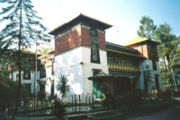
Apart from the major religious festivals of Diwali, Christmas, Dussera, Holi etc., the diverse ethnic populace of the town celebrates several local festivals. The Lepchas and Bhutias celebrate new year in January. while Tibetans celebrate the new year ( Losar) with " Devil Dance" in January–February. The Maghe sankranti, Ram Navami, Chotrul Duchen, Buddha Jayanti, the birthday of the Dalai Lama, Loosong, Bhumchu, Saga Dawa, Lhabab Duechen and Drupka Teshi are some other festivals, some distinct to local culture and others shared with the rest of India, Nepal, Bhutan and Tibet.
A popular food in Gangtok is the momo, a steamed dumpling containing pork, beef and vegetables cooked in a doughy wrapping and served with watery soup. Wai-Wai is a packaged snack consisting of noodles which are eaten either dry or in soup form. A form of noodle called thukpa, served in soup form is also popular in Gangtok. Other noodle-based foods such as the chowmein, thanthuk, fakthu, gyathuk and wonton are available. Other traditional Sikkimese cuisine include shah-phaley (a Sikkimese patties with spiced minced meat in a crisp samosa-like case) and Gack-ko soup. Restaurants offer a wide variety of traditional Indian, continental and Chinese cuisines to cater to the tourists. Churpee, a kind of hard cheese made from cow's or yak's milk is sometimes chewed. Chhang is a local frothy millet beer traditionally served in bamboo tankards and drunk through bamboo or cane straws. Alcohol is cheap due to low excise duty in Sikkim. Beer, whiskey, rum and brandy are frequently consumed by both locals and non-locals.
Residents of Sikkim are music lovers and it is common to hear Western rock music being played in homes and restaurants. Hindi pop songs are also common. Indigenous Nepali rock, music suffused with a western rock beat and Nepali lyrics, is particularly popular. Football (soccer), cricket and archery are the most popular sports in Gangtok. The Paljor Stadium, which hosts football matches, is the sole sporting ground in the city. Thangka—a notable handicraft—is an elaborately hand painted religious scroll in brilliant colours drawn on fabric hung in a monastery or a family altar and occasionally carried by monks in ceremonial processions. Chhaams are vividly costumed monastic dances performed on ceremonial and festive occasions, especially in the monasteries during the Tibetan new year.
City institutions

A centre of Buddhist learning and culture, Gangtok's most notable Buddhist institutions are the Enchey monastery, the Do-drul Chorten stupa complex and the Rumtek Monastery. The Enchey monastery is the city's oldest monastery and is the seat of the Nyingma order. The two-hundred year old baroque monastery houses images of gods, goddesses, and other religious artifacts. In the month of January, the Chaam, or masked dance, is performed with great fanfare. The Dro-dul Chorten is a stupa which was constructed in 1945 by Trulshi Rimpoché, head of the Nyingma order of Tibetan Buddhism. Inside this stupa are complete set of relics, holy books, and mantras. Surrounding the edifice are 108 Mani Lhakor, or prayer wheels. The complex also houses a religious school.
The Rumtek Monastery on the outskirts of the town is one of Buddhism's most sacred monasteries. The monastery is the seat of the Kagyu order, one of the major Tibetan sects, and houses some of the world's most sacred and rare Tibetan Buddhist scriptures and religious objects in its reliquary. Constructed in the 1960s, the building is modelled after a similar monastery in Lhasa, Tibet. Rumtek was the focus of international media attention in 2000 after the seventeenth Karmapa, one of the four holiest lamas, fled Lhasa and sought refuge in the monastery.
The Namgyal Institute of Tibetology, better known as the Tibetology Museum, houses a huge collection of masks, Buddhist scriptures, statues, and tapestries. It has over two hundred Buddhist icons, and is a centre of study of Buddhist philosophy. The Ganesh Tok and the Hanuman Tok, dedicated to the Hindu gods Ganpati and Hanuman and housing important Hindu temples, are located in the upper reaches of the town.
The Himalayan Zoological Park exhibits the fauna of the Himalayas in their natural habitats. The zoo features the Himalayan Black Bear, the barking deer, the snow leopard, the leopard cat, tibetan wolf, Masked Palm Civet, red pandas and the spotted deer amongst the others. Jawaharlal Nehru Botanical Gardens, near Rumtek, houses many species of orchid and as many as fifty different species of tree, including many oaks.
Education
Gangtok's schools are either run by the state government or by private and religious organisations. Schools mainly use English and Nepali as their medium of instruction. The schools are either affiliated with the Indian Certificate of Secondary Education or the Central Board of Secondary Education. Notable schools include the Tashi Namgyal Academy, Paljor Namgyal Girls School and Kendriya Vidyalaya. Colleges conferring graduate degrees include Sikkim Government College, Sikkim Government Law College and Damber Singh College. Gangtok does not have a university within the city limits. However, 8 km (5.0 mi) from here is the headquarters of the Sikkim Manipal University, which houses Sikkim Manipal Institute of Medical Sciences and Manipal Institute of Technology. There are other institutions offering diplomas in Buddhist literature, catering and other non-mainstream fields. District Institute of Education and Training and State Institute of Education conduct teacher training programs. Students usually go to large cities in the vicinity such as Siliguri or Kolkata in pursuit of higher education.
